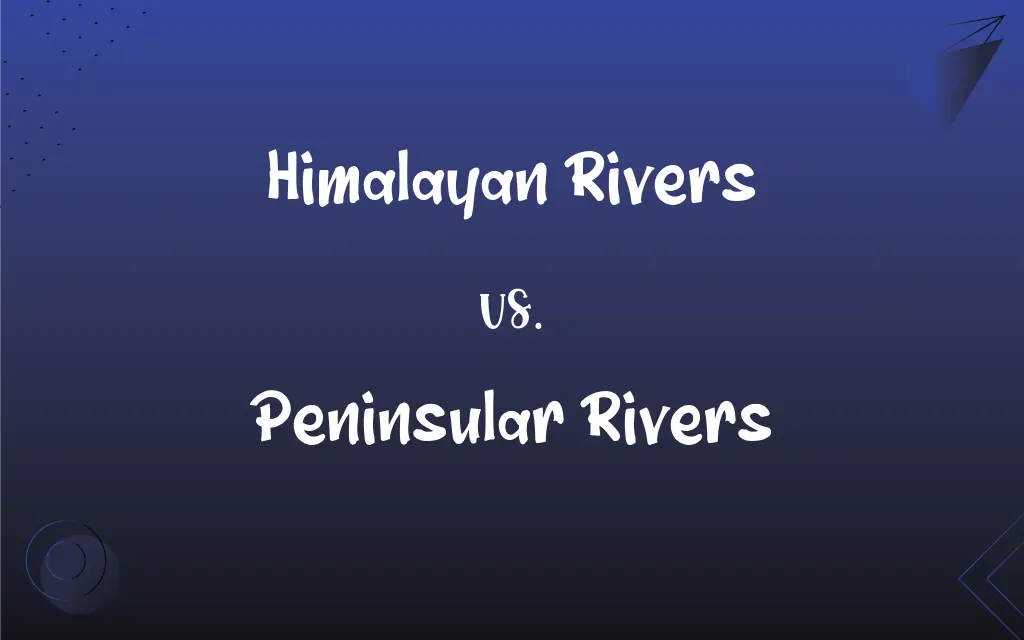Himalayan Rivers vs. Peninsular Rivers: What's the Difference?
Edited by Janet White || By Harlon Moss || Updated on October 25, 2023
Himalayan rivers originate from the Himalayas and are perennial; peninsular rivers stem from the Indian Peninsula and are largely seasonal.

Key Differences
Himalayan rivers and peninsular rivers, while both significant to the Indian subcontinent, differ in many aspects. Himalayan rivers, as the name suggests, have their sources in the mighty Himalayas. They are snow-fed and thus remain perennial, flowing consistently throughout the year.
In contrast, peninsular rivers originate from the plateau region of the Indian Peninsula. Predominantly rain-fed, their flow greatly varies with the seasons, becoming particularly robust during the monsoon and diminishing or even drying up in other months.
The path these rivers traverse is also distinctive. Himalayan rivers typically display extensive meandering, creating vast plains rich in alluvial soil, favorable for agriculture. Peninsular rivers, on the other hand, have shorter courses, passing through rocky terrains and descending from plateaus through steep gradients, often forming waterfalls.
From an economic standpoint, Himalayan rivers play a pivotal role in irrigation and hydroelectric power generation due to their perennial nature. The peninsular rivers, given their seasonal flow, contribute differently, supporting agriculture mainly during the monsoons while also being integral to the local ecosystems.
In cultural context, both river types hold spiritual significance. Himalayan rivers, especially the Ganges, are deeply embedded in Indian spiritual and cultural narratives. Similarly, many peninsular rivers, like the Godavari and Kaveri, are revered and associated with various religious events and practices.
ADVERTISEMENT
Comparison Chart
Origin
From the Himalayan mountains.
From the Indian Peninsula plateau region.
Nature
Perennial (flows throughout the year).
Largely seasonal (varies with monsoons).
Terrain Traversed
Extensive plains with rich alluvial soil.
Rocky terrains, plateaus, often forming waterfalls.
Economic Significance
Key for irrigation and hydroelectric power.
Supports agriculture during monsoons, important for local ecosystems.
Cultural Importance
Deeply rooted in spiritual narratives (e.g., Ganges).
Revered in many regions (e.g., Godavari, Kaveri).
ADVERTISEMENT
Himalayan Rivers and Peninsular Rivers Definitions
Himalayan Rivers
Rivers originating from the Himalayas.
The Ganges is one of the most prominent Himalayan rivers.
Peninsular Rivers
Rivers stemming from the Indian Peninsula.
The Godavari is a major peninsular river flowing eastward into the Bay of Bengal.
Himalayan Rivers
Snow-fed and perennial waterways.
Due to their consistent flow, Himalayan rivers support extensive agriculture.
Peninsular Rivers
Mainly rain-fed and seasonal.
Many peninsular rivers swell during the monsoon, providing vital water resources.
Himalayan Rivers
Characterized by extensive meandering.
The fertile plains created by the Himalayan rivers have historically attracted settlements.
Peninsular Rivers
Culturally significant in many regions.
Festivals along peninsular rivers, like the Kaveri Pushkaram, attract many attendees.
Himalayan Rivers
Significant for hydroelectric projects.
Many dams have been constructed on Himalayan rivers to harness their energy.
Peninsular Rivers
Integral to regional ecosystems.
The deltas formed by peninsular rivers support diverse flora and fauna.
Himalayan Rivers
Hold profound spiritual significance.
Himalayan rivers, especially the Ganges, draw millions of pilgrims annually.
Peninsular Rivers
Shorter courses with rocky terrains.
The waterfalls formed by peninsular rivers are popular tourist attractions.
FAQs
Are peninsular rivers perennial?
No, most peninsular rivers are seasonal, with flow depending on monsoonal rains.
Where do Himalayan rivers originate?
Himalayan rivers originate from the Himalayan mountain range.
Which river type has more waterfalls?
Peninsular rivers, due to their descent from plateaus through rocky terrains.
Are Himalayan rivers significant for power generation?
Yes, their perennial nature is harnessed for hydroelectric projects.
Which river type tends to have a steeper gradient?
Peninsular rivers, due to their descent from the plateau region.
Is agriculture dependent on Himalayan rivers?
Yes, their perennial nature supports extensive irrigation and agriculture.
How are peninsular rivers important for biodiversity?
They support diverse ecosystems, especially in their deltas.
Why are some peninsular rivers considered holy?
They hold cultural and spiritual significance in many Indian traditions.
Why do peninsular rivers sometimes dry up?
Their flow is rain-dependent; inadequate monsoons can reduce their flow.
Do peninsular rivers support major fisheries?
Yes, especially in their deltas and estuaries.
What causes the consistent flow of Himalayan rivers?
They are snow-fed, receiving meltwater from the Himalayan glaciers.
Do Himalayan rivers have deltas?
Yes, like the Sundarbans delta formed by the Ganges and Brahmaputra.
Which is the longest peninsular river?
The Godavari is the longest peninsular river.
Which river type is more navigable?
Himalayan rivers, due to their broader and deeper channels.
Are both river types found only in India?
While prominent in India, Himalayan rivers also flow through other countries.
Can Himalayan rivers dry up?
While they flow consistently, climate change and glacial retreat might affect them.
Are there dams on peninsular rivers?
Yes, dams like the Nagarjuna Sagar on the Krishna river are on peninsular rivers.
Why are Himalayan rivers clouded with silt?
Erosion in the Himalayas leads to a high silt load in these rivers.
Are there major cities along Himalayan rivers?
Yes, cities like Varanasi and Patna are on the banks of Himalayan rivers.
Do peninsular rivers have alluvial plains?
Unlike Himalayan rivers, they have limited alluvial plains.
About Author
Written by
Harlon MossHarlon is a seasoned quality moderator and accomplished content writer for Difference Wiki. An alumnus of the prestigious University of California, he earned his degree in Computer Science. Leveraging his academic background, Harlon brings a meticulous and informed perspective to his work, ensuring content accuracy and excellence.
Edited by
Janet WhiteJanet White has been an esteemed writer and blogger for Difference Wiki. Holding a Master's degree in Science and Medical Journalism from the prestigious Boston University, she has consistently demonstrated her expertise and passion for her field. When she's not immersed in her work, Janet relishes her time exercising, delving into a good book, and cherishing moments with friends and family.
































































